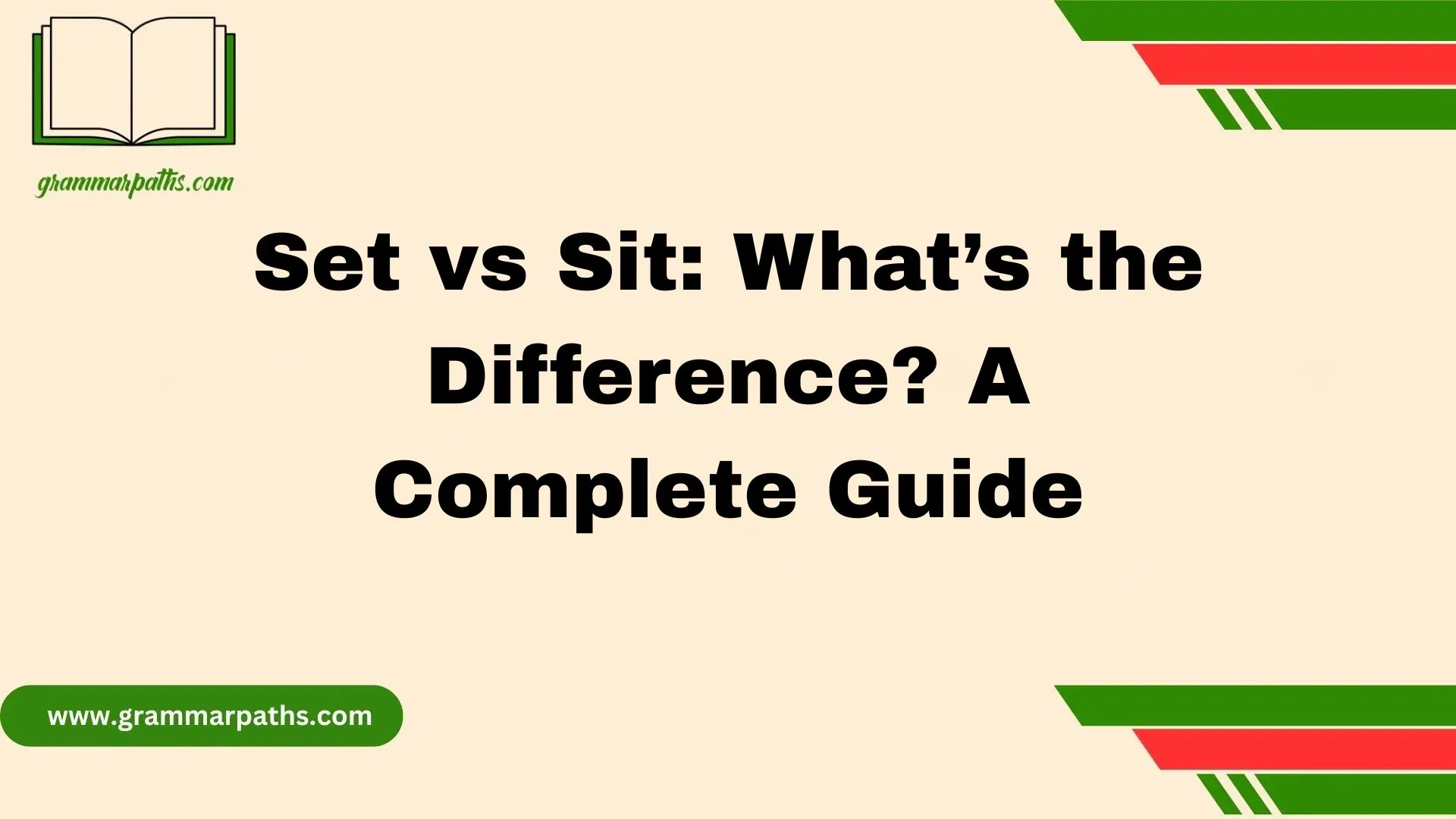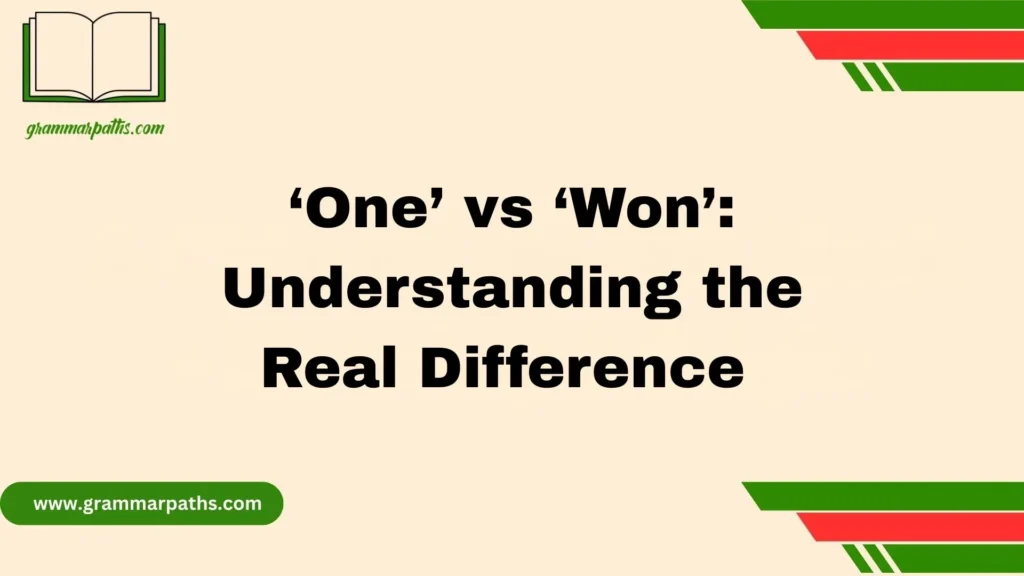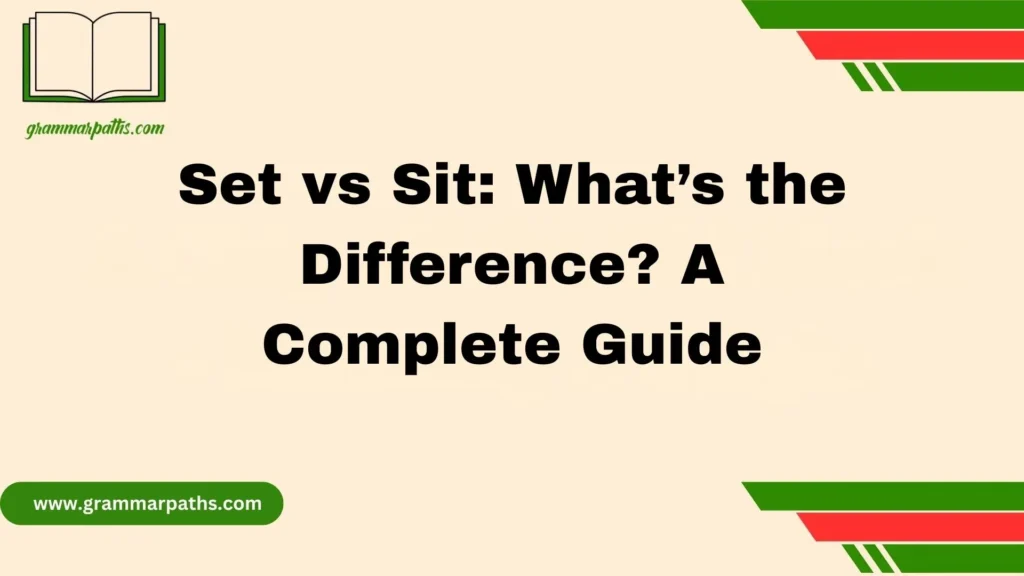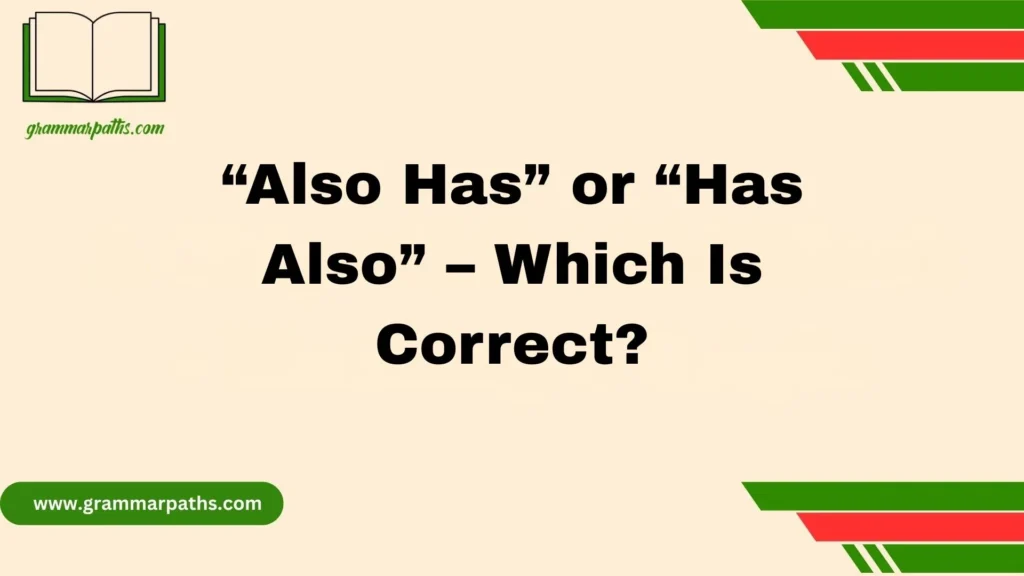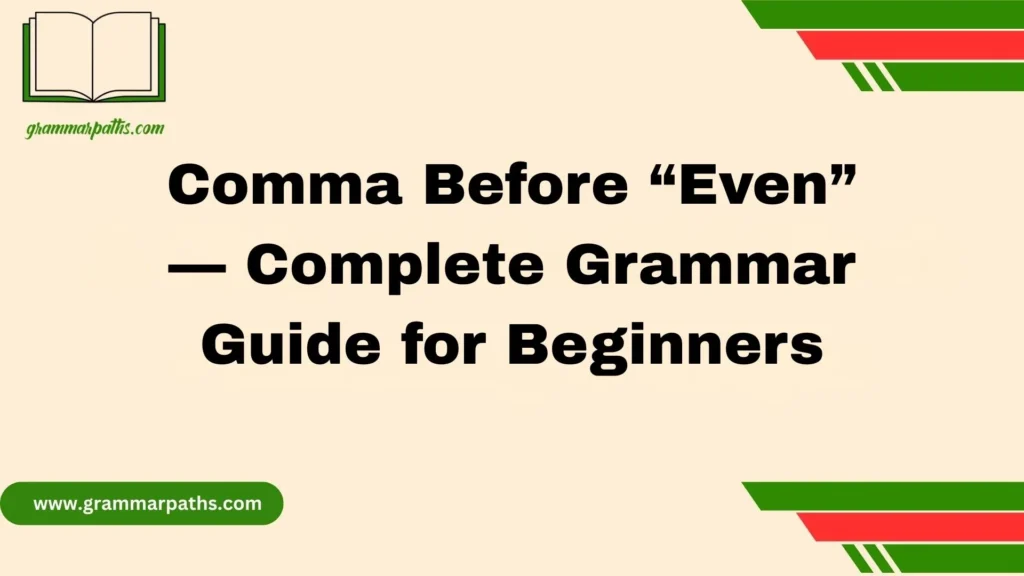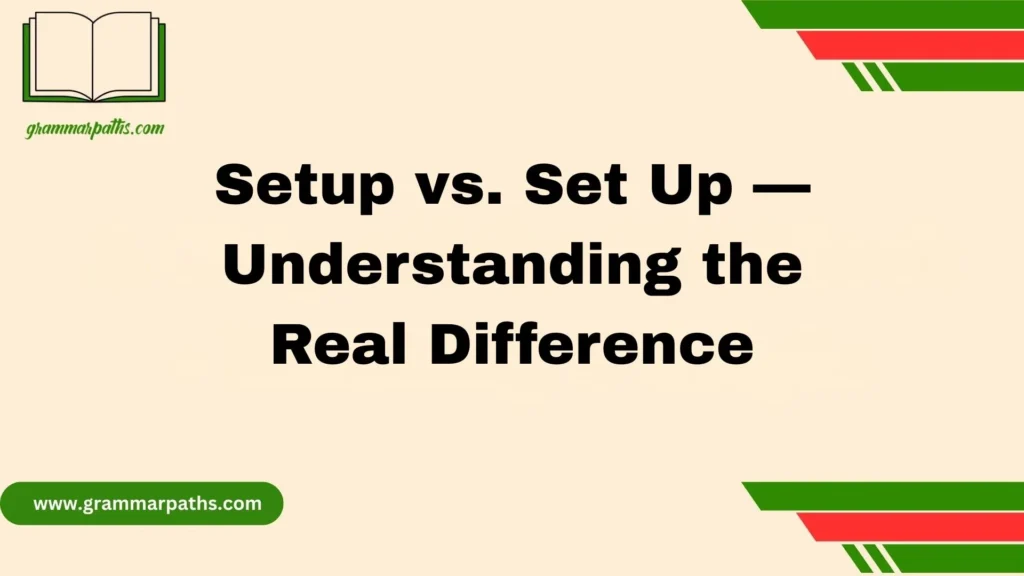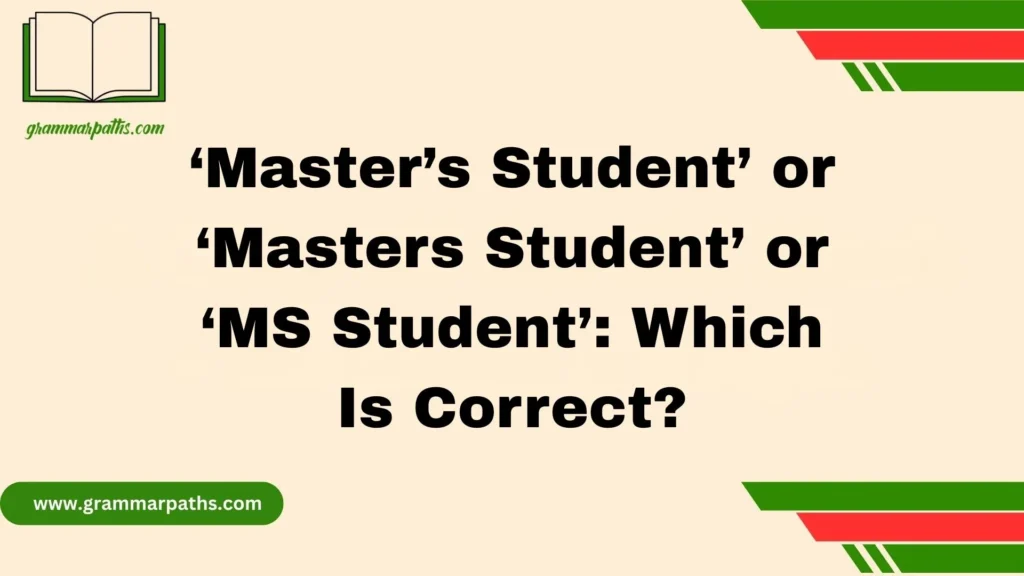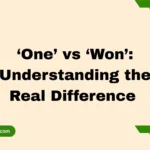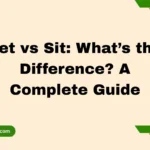When I first started learning English, I often got confused between sit and set because their spelling and pronunciation sounded so close. But the real difference lies in how each verb is used. The meaning of sit is simple—it’s when your weight is balanced on your buttocks and your back is straight, like when you sit on a chair, bed, floor, or stool. I remember my teacher once said, “If you’re sitting, you’re resting; if you’re setting, you’re placing.” That helped me a lot. The word sit comes from the Old English term sittan, which means “to occupy a seat.” It’s an irregular verb, conjugated as sit, sits, and sat.
In many circumstances, learners forget how these verbs change in sentences, especially when examples involve more than one place or number of people. You might set a book down, but you sit to read it. In academic or business settings, or even governmental and judicial institutions, you might hear phrases like “The committee sits today,” showing how the word can also accommodate formal use. Once you understand how these terms are derived, their true means become clear, and English feels a little less tricky.
Set vs Sit: Quick Comparison Table
Before diving deep, here’s a clear table showing the basic differences between “set” and “sit” in American English.
| Feature | Set | Sit |
| Basic Meaning | To place or put something somewhere | To rest or take a seated position |
| Type of Verb | Transitive (needs an object) | Intransitive (no object needed) |
| Example | She set the coffee cup on the table. | She sat on the couch. |
| Past Tense | Set | Sat |
| Continuous Form | Setting | Sitting |
| Example Error | “Set down here” ❌ | “Sit down here” ✅ |
Key takeaway:
You set something down, but you sit yourself down.
Understanding the Core Difference
Let’s simplify things:
- Set means to put or place something somewhere.
- Sit means to take a seat or be in a seated position.
Think of it this way: if the action involves an object, use set. If it involves you or another person resting, use sit.
Example Sentences
- I set my bag on the chair before I sat down.
- Please set your phone on silent and sit quietly.
- I set on the chair all day. → Correct form: I sat on the chair all day.
Analogy:
Imagine your hand is doing the action—then it’s set.
If your body is doing the action—then it’s sit.
The Origins and Etymology of ‘Set’ and ‘Sit’
Understanding where these words come from helps explain their difference in meaning and usage.
The Root of “Sit”: Derived from Old English “Sittan”
The word “sit” comes from the Old English verb sittan, which meant to rest or to be seated. Over time, it kept its meaning with very little change.
In Middle English, people used forms like sitte and sitten, which eventually simplified into sit and sat. Its meaning has remained consistent: it’s always about a person or thing being in a resting or seated position.
Example from Old Texts:
“He bad me sitte adown by him.” (Old Middle English)
The Evolution of “Set”: From Old English “Settan”
The verb “set” came from settan, meaning to cause to sit or to place. So, historically, “set” literally meant make something sit.
That origin explains why “set” involves an object—you’re causing something else to be placed or positioned.
Over time, set evolved to have more than 200 meanings in English, making it one of the most versatile verbs in the language. It’s used for everything from placing objects (set the keys down) to establishing rules (set boundaries) and adjusting devices (set the alarm clock).
Verb Forms and Conjugation: ‘Set’ vs ‘Sit’ in All Tenses
Both verbs are irregular, but “set” is easier because it doesn’t change form across tenses.
| Tense | Set | Sit |
| Present | set / sets | sit / sits |
| Past | set | sat |
| Past Participle | set | sat |
| Present Participle | setting | sitting |
| Example | I set the alarm every night. | I sit on my porch in the morning. |
Grammar Tip
Never say “setted” or “sitted.” Those forms don’t exist in modern English.
Deep Dive: Understanding “Set”
Primary Meaning: To Place or Put Something
When you set something, you’re moving or positioning an object.
Examples:
- She set the laptop on the desk.
- Please set the dishes on the table.
- He set the child’s backpack by the door.
In every example, the verb has an object (laptop, dishes, backpack). That’s what makes set a transitive verb.
Extended Meanings of “Set”
Set isn’t just about placing things—it’s one of English’s most flexible verbs.
| Context | Meaning | Example |
| Arranging | To organize or prepare | She set the stage for success. |
| Establishing | To decide or fix | The manager set a meeting for Friday. |
| Starting | To begin or activate | They set the timer for ten minutes. |
| Hardening | To become firm or solid | The glue set overnight. |
| Adjusting | To tune or align | He set the thermostat to 72°F. |
Idioms and Phrases with “Set”
| Phrase | Meaning | Example |
| Set in stone | Unchangeable | The deadline is set in stone. |
| Set the record straight | Correct a misunderstanding | She set the record straight about the rumor. |
| Set your sights on | Aim for a goal | He set his sights on becoming a lawyer. |
| Set up | Arrange or prepare | We set up the room for the meeting. |
| Set off | Begin a journey or reaction | The fireworks set off a chain of applause. |
Deep Dive: Understanding “Sit”
Primary Meaning: To Be in a Seated Position
When you sit, you rest your body on a surface such as a chair or bench.
Sit doesn’t take an object—it’s intransitive.
Examples:
- I sit here every morning.
- Please sit while you wait.
- The students sat quietly as the teacher spoke.
Extended Meanings of “Sit”
Like set, sit has grown beyond its literal sense.
| Context | Meaning | Example |
| Location | To be positioned | The house sits on a hill. |
| Inactivity | To remain unused or still | The car sat in the garage all winter. |
| Participation | To serve or take part | She sits on the company board. |
| Examination | To take a test | They will sit for the SAT next month. |
Idioms and Phrases with “Sit”
| Phrase | Meaning | Example |
| Sit tight | Wait patiently | Just sit tight—I’ll handle it. |
| Sit still | Stay calm or unmoving | Kids rarely sit still in class. |
| Sit well with | Be acceptable | That comment didn’t sit well with me. |
| Sit in on | Attend without participating | I’ll sit in on the meeting. |
| Sit back and relax | Take it easy | After work, I just sit back and relax. |
Common Mistakes and Misconceptions
Mistakes with set and sit usually happen when people confuse who or what is acting in the sentence.
Example Errors:
- “I set on the sofa to watch TV.”
Correct: “I sat on the sofa to watch TV.”- “He sat the glass on the table.”
Correct: “He set the glass on the table.”
Why People Confuse Them
Both verbs relate to position or placement, but one applies to objects and the other to people or living things.
Remember: you can’t set yourself (unless you’re playing volleyball!).
Illustrative Scenarios: How “Set” and “Sit” Work in Everyday Life
In the Classroom
- “Students, please sit down.”
- “Now set your books on the desk.”
At Home
- “Could you set the table for dinner?”
- “After dinner, let’s sit together and watch a movie.”
At Work
- “Let’s set the agenda for tomorrow’s meeting.”
- “Please sit in on the presentation.”
Case Study: The Cost of Misusing “Set” and “Sit”
In a professional email, one small error can change how competent you appear.
Example:
“Please set in the conference room while I prepare.”
“Please sit in the conference room while I prepare.”
The first version sounds awkward and confusing, while the second sounds natural and professional.
That tiny difference can make your communication clearer—and your image stronger.
Practical Tips to Remember the Difference
Here are easy tricks to help the difference stick in your mind.
- Tip 1: You set an object, but you sit yourself.
- Tip 2: If your sentence has a thing, use set. If it’s about a person, use sit.
- Tip 3: Remember the phrase “Set it down before you sit down.”
Mnemonic Chart
| Verb | Think Of | Example |
| Set | Action with an object | “Set the phone on the desk.” |
| Sit | Resting yourself | “Sit on the chair.” |
Quick Quiz: Test Your Understanding
Fill in the blanks with set or sit.
- Please ____ your backpack on the floor.
- You may ____ here while you wait.
- She ____ the alarm for 6:30 a.m.
- The house ____ at the end of the street.
- He ____ the vase carefully on the shelf.
Answers:
- set
- sit
- set
- sits
- set
Recap and Final Thoughts
Let’s summarize the core ideas you should remember:
- Set = action you do to something else.
- Sit = action you do yourself.
- Set is transitive, Sit is intransitive.
- Past tense of Set = Set; past tense of Sit = Sat.
- Practice makes perfect—use them in daily conversation and writing.
“The difference between set and sit isn’t just grammar—it’s precision in how you express action and position.”
Conclusion
In the end, understanding the difference between sit and set makes English feel more natural and less confusing. Both words may look similar in spelling and pronunciation, but their meaning and use in sentences are quite distinct. Remember, you sit when your weight is balanced on your buttocks with your back straight, and you set something when you cause it to rest or occupy a place. Once you master how each verb is conjugated, whether in academic, business, or governmental contexts, you’ll communicate with more confidence and precision.
FAQs
1. What is the main difference between “sit” and “set”?
The word sit means to be in a resting posture, while set means to place or put something down.
2. Is “sit” an irregular verb?
Yes. Sit is an irregular verb. It’s conjugated as sit, sits, and sat.
3. Can “set” be used without an object?
No. Set usually requires an object. For example, “Set the book on the table.”
4. What does “sit” come from?
The word sit is derived from the Old English word sittan, which means “to occupy a seat.”
5. When should I use “sit” or “set” in professional contexts?
Use sit when referring to being part of a judicial, academic, or business institution (e.g., “The board sits on Monday”), and set when referring to placing or arranging something (e.g., “We set the agenda for the meeting”).
References and Resources
- Merriam-Webster Dictionary – “Set” Definition
- Merriam-Webster Dictionary – “Sit” Definition
- Cambridge Dictionary – Set vs Sit Usage
- Grammarly Blog – Commonly Confused Words

Emma Brooke is a passionate language expert and contributor at GrammarPaths.com, where she helps learners navigate the complexities of English grammar, idioms, and effective writing. With a strong academic background and years of teaching experience, Emma excels at turning tricky grammar rules into simple, practical lessons that readers can easily grasp.
